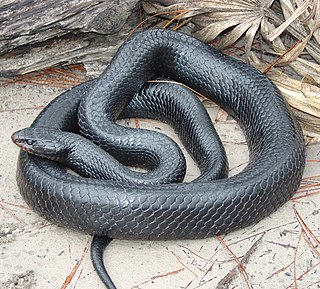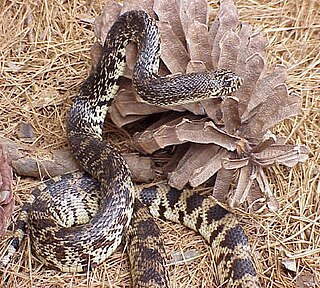
Pantherophis obsoletus, also known commonly as the western rat snake, black rat snake, pilot black snake, or simply black snake, is a nonvenomous species of snake in the family Colubridae. The species is native to central North America. There are no subspecies that are recognized as being valid. Its color variations include the Texas rat snake. Along with other snakes of the eastern United States, like the eastern indigo snake and the eastern racer, it is called “black snake”.

The wild turkey is an upland game bird native to North America, one of two extant species of turkey and the heaviest member of the order Galliformes. It is the ancestor to the domestic turkey, which was originally derived from a southern Mexican subspecies of wild turkey.

The burrowing owl, also called the shoco, is a small, long-legged owl found throughout open landscapes of North and South America. Burrowing owls can be found in grasslands, rangelands, agricultural areas, deserts, or any other open, dry area with low vegetation. They nest and roost in burrows, such as those excavated by prairie dogs. Unlike most owls, burrowing owls are often active during the day, although they tend to avoid the midday heat. Like many other kinds of owls, though, burrowing owls do most of their hunting during dusk and dawn, when they can use their night vision and hearing to their advantage. Living in open grasslands as opposed to forests, the burrowing owl has developed longer legs that enable it to sprint, as well as fly, when hunting.

The slender glass lizard is a legless lizard in the glass lizard subfamily (Anguinae). The species is endemic to the United States. Two subspecies are recognized. The lizard was originally believed to be a subspecies of the eastern glass lizard. Their name comes from their easily broken tail which they can break off themselves without ever being touched. It is difficult to find a specimen with an undamaged tail. The lizard eats a variety of insects and small animals, including smaller lizards. Snakes and other animals are known to prey on the species. Humans have a part in destroying their environment and killing their food supply with insecticides. The lizard is considered to be a least-concern species according to the International Union for Conservation of Nature (IUCN), though it is vulnerable in Iowa and endangered in Wisconsin. It is important to note that the streamlined, legless species is often confused with snakes. Glass Lizards, however, differ from snakes as they possess a moveable eyelid, which is absent in snakes. Another way to distinguish glass lizards from snakes is the presence of an external ear opening, which are absent in snakes.

The scarlet kingsnake or scarlet milk snake is a species of kingsnake found in the southeastern and eastern portions of the United States. Like all kingsnakes, they are nonvenomous. They are found in pine flatwoods, hydric hammocks, pine savannas, mesic pine-oak forests, prairies, cultivated fields, and a variety of suburban habitats; not unusually, people find scarlet kingsnakes in their swimming pools, especially during the spring. Until recently, and for much of the 20th century, scarlet kingsnakes were considered a subspecies of the milk snake; however, Pyron and Bubrink demonstrated the phylogenetic distinction of this species and its closer relationship to the mountain kingsnakes of the southwestern United States. These largely fossorial snakes are the smallest of all the species within the genus Lampropeltis, usually ranging from 40 to 50 cm at maturity. The maximum recorded length is in Jonesboro, AR 76.2 cm (30.0 in). Hatchlings range in size from 8 to 18 cm .

The eastern indigo snake is a species of large, non-venomous snake in the family Colubridae. Native to the southeastern United States, it is the longest native snake species in the country.

Drymarchon is a genus of large nonvenomous colubrid snakes, commonly known as indigo snakes or cribos, found in the Southeastern United States, Mexico, Central America, and South America.

The Indian python is a large python species native to tropical and subtropical regions of the Indian subcontinent and Southeast Asia. It is also known by the common names black-tailed python, Indian rock python, and Asian rock python. Although smaller than its close relative the Burmese python, it is still among the largest snakes in the world. It is generally lighter colored than the Burmese python and reaches usually 3 m. Like all pythons, it is nonvenomous.

The eastern hog-nosed snake, is a species of mildly venomous rear-fanged snake in the family Colubridae. The venom is specifically adapted to amphibian prey and is harmless to humans. However, some people may have an allergic reaction, and experience local swelling and other symptoms. The species is endemic to North America. There are no subspecies that are recognized as being valid. This species prefers habitats with sandy soils and a combination of grass fields and forest edges. They come in many different colorations and have the identifiable upturned "snout". They can be found in captivity but are a relatively difficult species to keep due to a specialized diet of toads. As with other Heterodon species, they have a distinctive threat reaction of first bluffing by striking with a closed mouth and then pretending to die if this fails to deter the threat.

Pituophis catenifer affinis, commonly known as the Sonoran gopher snake, is a nonvenomous subspecies of colubrid snake that is endemic to the southwestern United States. It is one of six recognized subspecies of the gopher snake, Pituophis catenifer.

Pituophis melanoleucus, commonly known as the eastern pine snake, is a species of nonvenomous snake in the family Colubridae. The species is endemic to the southeastern United States. Three subspecies are currently recognized as being valid.

The black sparrowhawk, sometimes known as the black goshawk or great sparrowhawk, is the largest species of True hawk in Africa. It occurs mainly in forest and non-desert areas south of the Sahara, particularly where there are large trees suitable for nesting; favored habitat includes suburban and human-altered landscapes. It preys predominantly on birds of moderate size, such as pigeons and doves, in suburban areas.
The Andros Island iguana or Andros iguana is an endangered subspecies of Northern Bahamian rock iguana of the genus Cyclura that is found on Andros Island on the western edge of Grand Bahama. Its status is Endangered, with a wild population of 3,500 animals, and it can be found on the IUCN Red List.

The Louisiana pine snake is a species of large, non-venomous, constrictor in the family Colubridae. This powerful snake is notable because of its large eggs and small clutch sizes. The Louisiana pine snake is indigenous to west-central Louisiana and East Texas, where it relies strongly on Baird's pocket gophers for its burrow system and as a food source. The Louisiana pine snake is rarely seen in the wild, and is considered to be one of the rarest snakes in North America. The demise of the species is due to its low fecundity coupled with the extensive loss of suitable habitat - the longleaf pine savannas in the Gulf coastal plain of the southeastern United States. Management activities are being conducted to promote the species' recovery.

The Pacific gopher snake is a subspecies of large non-venomous colubrid snake native to the western coast of North America.

The Florida crowned snake is a species of colubrid snake found in Florida and Georgia. It is a small, slender, non-venomous snake that is rarely seen. The species is commonly found in north and central Florida, and is most often associated with sandy habitats.

Pituophis catenifer deserticola, commonly known by its standardized English name since the 1950s, the Great Basin gophersnake, is a subspecies of nonvenomous colubrid snake ranging in parts of western United States and adjacent southwestern Canada.

Masticophis flagellum flagellum, commonly known as the Eastern coachwhip, is a subspecies of M. flagellum, a nonvenomous, colubrid snake, endemic to the southern United States.

Pituophis deppei, commonly known as the Mexican bullsnake and the Mexican pine snake, is a species of nonvenomous colubrid snake endemic to Mexico. There are two recognized subspecies.

Pituophis melanoleucus lodingi, commonly known as the black pinesnake or black pine snake, is a subspecies of nonvenomous snake in the family Colubridae. The species is endemic to southern Mississippi and southwestern Alabama. It is one of three subspecies of the species Pituophis melanoleucus.























